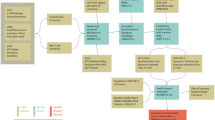Abstract
Recent research has revealed that human exposure to air pollutants such as CO, NO X , and particulates can lead to respiratory diseases, especially among school-age children. Towards understanding such health impacts, this work estimates local-scale vehicular emissions and concentrations near a highway traffic network, where a school zone is located in. In the case study, VISSIM traffic micro-simulation is used to estimate the source of vehicular emissions at each roadway segment. The local-scale emission sources are then used as inputs to the California line source dispersion model (CALINE4) to estimate concentrations across the study area. To justify the local-scale emissions modeling approach, the simulation experiment is conducted under various traffic conditions. Different meteorological conditions are considered for emission dispersion. The work reveals that emission concentrations are usually higher at locations closer to the congested segments, freeway ramps and major arterial intersections. Compared to the macroscopic estimation (i.e. using network-average emission factors), the results show significantly different emission patterns when the local-scale emission modeling approach is used. In particular, it is found that the macroscopic approach over-estimates emission concentrations at freeways and under-estimations are observed at arterials and local streets. The results of the study can be used to compare to the US environmental protection agency (EPA) standards or any other air quality standard to further identify health risk in a fine-grained manner.
Similar content being viewed by others
References
US National Research Council. The congestion mitigation and air quality improvement program: Assessing 10 years of experience [M]. Washington D C: Transportation Research Board, 2002.
DONHAM K J, LEISTIKOW B, MERCHANT J, LEONARD S. Assessment of US poultry worker respiratory risks [J]. American Journal of Industrial Medicine, 1990, 17(1): 73–74.
SABIN L D, KOZAWA K, BEHRENTZ E, WINER A M, FITZ D R, PANKRATZ D V, FRUIN S A. Analysis of real-time variables affecting children’s exposure to diesel-related pollutants during school bus commutes in los angeles [J]. Atmospheric Environment, 2005, 39(29): 5243–5254.
US Environmental Protection Agency (EPA). National ambient air quality standards (NAAQS) [EB/OL]. [2010-11-17]. https://www3. epa.gov/ttn/naaqs/criteria.html.
WITTENBERG B A, WITTENBERG J B. Effects of carbon monoxide on isolated heart muscle cells [J]. Research Report Health Effects Institute, 1993, 62: 1–12.
US Environmental Protection Agency (EPA). Fact sheet proposed revisions to the national ambient air quality standards for nitrogen dioxide [EB/OL]. [2009-07-22]. https://www3.epa.gov/airquality/ nitrogenoxides/pdfs/20090722fs.pdf.
ABOU-SENNA H, RADWAN E, WESTERLUND K, COOPER C D. Using a traffic simulation model (VISSIM) with an emissions model (MOVES) to predict emissions from vehicles on a limited-access highway [J]. Journal of the Air & Waste Management Association, 2013, 63(7): 819–831.
CHU H C, MEYER M D. Methodology for assessing emission reduction of truck-only toll lanes [J]. Energy Policy, 2009, 37(8): 3287–3294.
de VLIEGER I. On board emission and fuel consumption measurement campaign on petrol-driven passenger cars [J]. Atmospheric Environment, 1997, 31(22): 3753–3761.
HALLMARK S L, GUENSLER R, FOMUNUNG I. Characterizing on-road variables that affect passenger vehicle modal operation [J]. Transportation Research Part D: Transport and Environment, 2002, 7(2): 81–98.
NESAMANI K S, CHU L, MCNALLY M G, JAYAKRISHNAN R. Estimation of vehicular emissions by capturing traffic variations [J]. Atmospheric Environment, 2007, 41(14): 2996–3008.
SUN Z, HAO P, BAN X, YANG D. Trajectory-based vehicle energy/emissions estimation for signalized arterials using mobile sensing data [J]. Transportation Research Part D: Transport and Environment, 2015, 34: 27–40.
BEYCHOK M R. Fundamentals of stack gas dispersion [M]. Newport Beach, CA: Milton R BETCHOK, 1994.
ARYA S P. Air pollution meteorology and dispersion [M]. Oxford: Oxford University Press, 1999.
ULIASZ M, BARTOCHOWSKA M, MADANY A, PIWKOWSKI H, PARFINIEWICZ J, ROZKRUT A. Application of the mesoscale dispersion modeling system to investigation of air pollution transport in southern Poland [M]. New York, US: Springer, 1994.
SHARMA N, CHADHRY K K, CHALAPATI RAO C V. Vehicular pollution prediction modelling: A review of highway dispersion models [J]. Transport Reviews, 2004, 24(4): 409–435.
LIN J, GE Y E. Impacts of traffic heterogeneity on roadside air pollution concentration [J]. Transportation Research Part D: Transport and Environment, 2006, 11(2): 166–170.
SAMARAAYAKE S, GLASER S, HOLSTIUS D, MONTEIL J, TRACTON K, SETO E, BAYEN A. Real-time estimation of pollution emissions and dispersion from highway traffic [J]. Computer-Aided Civil and Infrastructure Engineering, 2014, 29(7): 546–558.
ZHANG K, STUART B. Air pollution and health risks due to vehicle traffic [J]. Science of the total Environment, 2013, 450: 307–316.
SMIT R, SMOKERS R, RABE E. A new modelling approach for road traffic emissions: VERSIT+ [J]. Transportation Research Part D: Transport and Environment, 2007, 12(6): 414–422.
BENSON P. CALINE4-A dispersion model for predicting air pollutant concentrations near roadways [R]. No. FHWA/CA/TL-84/15, 1984.
BAN X, SUN Z. Simulation-based decision-making tool for adaptive traffic signal control on tarry town road in the city of white plains [R]. NY: New York State Department of Transportation, C-10-03, 2013.
Illinois Department of Transportation. Transportation Data Management System [EB/OL]. [2013-11-26]. http://idot.ms2soft. com/tcds/tsearch.asp?loc=Idot&mod.
Author information
Authors and Affiliations
Corresponding author
Rights and permissions
About this article
Cite this article
Alzuhairi, A., Aldhaheri, M., Sun, Zb. et al. Vehicular emissions and concentrations in school zones: A case study. J. Cent. South Univ. 23, 1778–1785 (2016). https://doi.org/10.1007/s11771-016-3231-9
Received:
Accepted:
Published:
Issue Date:
DOI: https://doi.org/10.1007/s11771-016-3231-9




